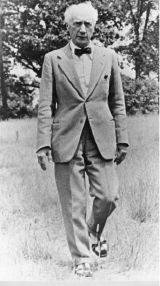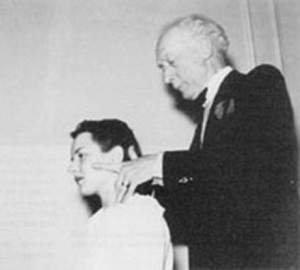Who was F. M. Alexander?
 Frederick Matthias Alexander was born in 1869 in rural Tasmania. By 1890 as he was becoming increasingly successful and popular in Melbourne as an actor, hoarseness would overcome him during performances. Having sought help in vain from the medical profession as well as vocal coaches, he concluded that the cause of his problem and therefore its potential solution, must lie in what he was doing with himself (body and vocal apparatus) while on stage performing. During the years that followed, he systematically observed himself with the help of mirrors while reciting as well as everyday speaking and proved his initial premise to be correct. He not only proved that how one uses themselves in any activity has a direct effect upon their overall functioning and therefore on the quality of the outcome or performance but was a pioneer in demonstrating the connection between the body and the mind. He was an inventor in the fullest sense of the word. We owe the Technique to his insightful inquisitive mind, his perseverance through a ten year systematic process of self observation and his endless eagerness to teach and learn.
Frederick Matthias Alexander was born in 1869 in rural Tasmania. By 1890 as he was becoming increasingly successful and popular in Melbourne as an actor, hoarseness would overcome him during performances. Having sought help in vain from the medical profession as well as vocal coaches, he concluded that the cause of his problem and therefore its potential solution, must lie in what he was doing with himself (body and vocal apparatus) while on stage performing. During the years that followed, he systematically observed himself with the help of mirrors while reciting as well as everyday speaking and proved his initial premise to be correct. He not only proved that how one uses themselves in any activity has a direct effect upon their overall functioning and therefore on the quality of the outcome or performance but was a pioneer in demonstrating the connection between the body and the mind. He was an inventor in the fullest sense of the word. We owe the Technique to his insightful inquisitive mind, his perseverance through a ten year systematic process of self observation and his endless eagerness to teach and learn.
By 1904 he was successfully teaching his technique and known in Sydney as “the breathing man”. Encouraged and recommended by medical and theater professionals, he moved to London to spread knowledge of his discoveries and work. He was met by success in prominent circles of actors, doctors and literary figures. To promote himself and “The Work” as he called it he wrote several pamphlets on the health benefits of the technique as well as its applications to breathing and voice production (reproduced in his Articles and Lectures) before the publishing his first book in 1910. In “Man’s Supreme Inheritance” Alexander evolves his theory that “the great phase in man’s advancement is that in which he passes from subconscious to conscious control of his own mind and body. In other words, our unique ability to make conscious choices about our behaviors is our “supreme inheritance”.
 Between 1914 and 1924 F.M. Alexander and his brother A.R. spend their time between New York and Boston. Alexander met, taught and became friends with John Dewey during this time, who wrote the forwards to Alexander next two books. Constructive Conscious Control of the Individual (1923) and Use of the Self (1930) Alexander’s most popular and straightforward book with his noteworthy step by step account of his discovery . In these books he further developed his thesis of the importance of conscious control in man’s evolution as well as present case studies and stories illustrating the effectiveness of the Alexander Technique in preventing and relieving a wide variety of symptoms.
Between 1914 and 1924 F.M. Alexander and his brother A.R. spend their time between New York and Boston. Alexander met, taught and became friends with John Dewey during this time, who wrote the forwards to Alexander next two books. Constructive Conscious Control of the Individual (1923) and Use of the Self (1930) Alexander’s most popular and straightforward book with his noteworthy step by step account of his discovery . In these books he further developed his thesis of the importance of conscious control in man’s evolution as well as present case studies and stories illustrating the effectiveness of the Alexander Technique in preventing and relieving a wide variety of symptoms.
Throughout the 20s and 30s, doctors, scientists, writers, performers, children and the disabled flocked to the Alexander’s for lessons. George Bernard Shaw, John Dewey, Aldous Huxley. Lenard Wolf, Sir Stafford Cripps, Archbishop of Canterbury and Earl Lytton were some of F.M’s well-known students.
The first teacher training course in the Alexander Technique, was established in London in 1931 as well as a children’s school (the “little school”) where education was based on the ‘means-whereby’ instead of ‘end-gaining’ and the children received daily instruction in the Alexander Technique and applying its principles.
In 1939 with WWII the little school was moved to the US, where Alexander taught again alongside his brother while writing his fourth and last book: Universal Constant in Living (1941), is more of a collection of articles, testimonials, anecdotes and news clippings that Alexander weaves together in his final attempt at clarifying the principle that our “wrong use will be a constant influence for ill” and conversely “an improving manner of use will exert a constant influence for good in the restoration and maintenance of psycho-physical efficiency” that we alone are responsible for.
Shortly before the end of the war in 1943 F.M. Alexander went back to London, resuming his teaching and training course there. In 1947 he suffered a stroke which left him paralyzed on the left side. Using his technique and its principles he made a full recovery and was teaching up until his death in 1955.
What are the main principles of the Alexander Technique?
My technique is based on inhibition, the inhibition of undesirable, unwanted responses to stimuli, and hence it is primarily a technique for the development of the control of human reaction.
F. Matthias Alexander
 The Alexander Technique concerns itself solely with “means”. It is a “means-whereby” technique as opposed to all other methods which are “end-gaining” ones. Practically speaking this means that the focus for both student and teacher of the Alexander Technique is on observing and increasing kinesthetic awareness of how and what s/he is doing physically and mentally while busy with a given activity. It matters little what that activity is or if the student is able to complete it immediately. The activity is considered successful when ease, lightness and a sense of freedom are experienced during and as part of the performance of the given activity. To the happy surprise of students, the goal is most often reached and effortlessly so.
The Alexander Technique concerns itself solely with “means”. It is a “means-whereby” technique as opposed to all other methods which are “end-gaining” ones. Practically speaking this means that the focus for both student and teacher of the Alexander Technique is on observing and increasing kinesthetic awareness of how and what s/he is doing physically and mentally while busy with a given activity. It matters little what that activity is or if the student is able to complete it immediately. The activity is considered successful when ease, lightness and a sense of freedom are experienced during and as part of the performance of the given activity. To the happy surprise of students, the goal is most often reached and effortlessly so.
How is the Alexander Technique different?
In order to distinguish the Alexander technique from other modalities advocating well-being, one needs to look at its characteristics and fundamental principles rather than at its results:
Kinesthesia, is our movement sense. We use it to perceive movement, position, tension and weight. It gives us information about ourselves in and relative to the environment rather than just about our environment. With the Alexander Technique one becomes keenly aware of variations in position, tension and weight throughout the body during movement.
Dr. Frank Pierce Jones, student of F.M. and A.R. Alexander, teacher of the Alexander Technique and former director of Tufts University Institute for Psychological Research, defines Primary control, as “a dynamic relationship between the center of gravity of the head and the vertebrae in the neck which allows the head to move in an orbit which promotes maximal lengthening of the spine and facilitates movement throughout the body.”
He goes on to define it in physiological terms as “a basic feedback mechanism which facilitates both reflex and voluntary movement by maintaining an optimal distribution of postural tonus.” During an Alexander lesson the teacher’s role is to bring kinesthetic awareness in their student of the mechanism of primary control.
Inhibition is the third essential and distinguishing cornerstone of the Alexander Technique. Alexandrian inhibition is not repressive of but rather releases spontaneity by withholding definition or suspending habitual impulses or responses to stimuli long enough for intelligent guidance and reasoning to intervene. During the moment of inhibition, we withhold our habitual definition of a given situation and give ourselves the space to consciously make a different choice, exercising, according to Alexander our “supreme inheritance”.
Mr Alexander has done a service to the subject [of the study of reflex and voluntary movement] by insistently treating each act as involving the whole integrated individual, the whole psychophysical man. To take a step is an affair, not of this or that limb solely, but of the total neuromuscular activity of the moment, not least of the head and neck.
Sir Charles Sherrington (1857-1952)
Neurophysiologist, Nobel Prize for Medicine 1932
We cannot ask more from any system of physical education; nor, if we seriously desire to alter human beings in a desirable direction, can we ask any less.
Aldous Huxley